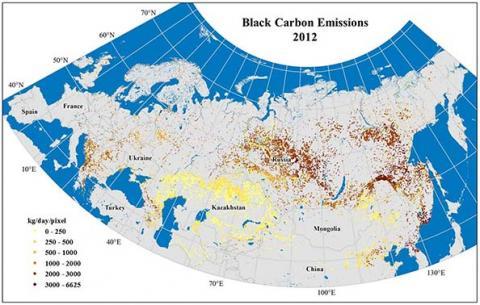Northern Eurasia covers 20% of the global land mass and contains 70% of the boreal forest. During certain times of the year, black carbon (BC) in smoke plumes at high latitudes may be transported and deposited on Arctic ice, thereby accelerating ice melting. It is thus imperative to better understand daily sources, transport, and deposition of BC in Northern Eurasia.
Scientists examined daily BC emissions from fires over different land cover types in Northern Eurasia at a 500 m x 500 m (1,640 ft x 1,640 ft) resolution from 2002 to 2013. Black carbon emissions were estimated from MODIS land cover maps and detected burned areas, the Forest Inventory Survey of the Russian Federation, and emission factors of BC for different types of vegetation fires. Our estimated annual burned areas in Northern Eurasia varied considerably from 160,000 km2 (~62,000 mi2; 2011) to 490,000 km2 (~189,000 mi2; 2003) with an average of 250,000 km2 (~96,000 mi2). Grassland dominates the total burned area (61%) and followed by forest (27%). For grassland fires, about three-quarters of the burned area occurred in Central and Western Asia and about 17% in Russia. More than 90% of the forest burned area was in Russia.
Annual BC emissions from fires varied enormously, but were dominated by forest fires, which accounted for about two-thirds of emissions, followed by grassland fires (15%). More than 90% of the BC emissions from forest fires occurred in Russia. Central and Western Asia is the major region for BC emissions from grassland fires. Overall, Russia contributed 83% of the total BC emissions from fires in Northern Eurasia. While results vary from year-to-year, there are no apparent trends in area burned or BC emissions from 2002 to 2013.
These results are critical in understanding the future impacts of climate change on the fire dynamics in Northern Eurasia and the contribution of black carbon to accelerated melting of Arctic ice.
